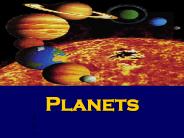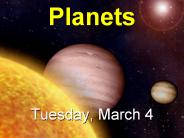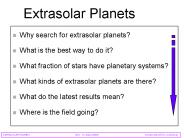Stars And Planets PowerPoint PPT Presentations
All Time
Recommended
Observing Planets and Stars S4E1. Students will compare and contrast the physical attributes of stars, star patterns, and planets. d. Identify how technology is used ...
| PowerPoint PPT presentation | free to download
The formation of stars and planets. Day 4, Topic 3: Agglomeration of particles ... Planetesimals agglomerate via gravitational interactions and form rocky planet ...
| PowerPoint PPT presentation | free to view
Formation of Stars and Planets Frank H. Shu National Tsing Hua University Arnold Lecture UC San Diego 6 May 2005 Outline of Talk Origin of solar system review ...
| PowerPoint PPT presentation | free to download
Chapter 4. Observing the Stars and Planets: ... 4.2a Eerie Lunar Eclipses ... figure); its overall appearance, in fact, is rather eerie and three-dimensional. ...
| PowerPoint PPT presentation | free to view
Pluto not considered an outer planet. JUPITER. Made primarily of ... Charon is more than half the size of Pluto. 1 day = just over 6 days 1 year = 248 years ...
| PowerPoint PPT presentation | free to view
7 known planets: HD 209458, TrES-1, OGLE-TR-10, 56, 111, 113, and 132 ... TrES-1. Model test results. Fit Parameters. Equations. 4 unknowns: M1, R1, M2, and R2 ...
| PowerPoint PPT presentation | free to download
... core remnant called a White Dwarf - a body with the mass of a star but only ... A Jovian planet in a neutron star white dwarf system ...
| PowerPoint PPT presentation | free to download
Chapter 5: Formation of Stars and Planets (and more) Part 2 - the Solar System EVERYTHING in the Solar System orbits the Sun! What is EVERYTHING?
| PowerPoint PPT presentation | free to view
Astrology is that the study of the influence that distant cosmic objects, typically stars and planets, have on human lives. The position of the sun, stars, moon and planets at the time of people's birth (not their conception) is said to shape their personality, have an effect on their romantic relationships and predict their economic fortunes, among different divinations. What most of the people know about astrology is their "sign," which refers to at least one of the 12 constellations of the zodiac. this is a kind of sun-sign astrology, which is the astrology upon which newspaper horoscopes are based mostly. To know more visit here: http://www.shukracharya.com/
| PowerPoint PPT presentation | free to download
This is an amazing perspective on the size relationship of our planets and stars. How small we are in the scope of the Universe...but still, how precious we are in ...
| PowerPoint PPT presentation | free to download
10 (Jupiter-like) to 100 (Earth-like) times smaller in diameter ... The presence of a planet can be inferred by observing a star and analyzing the ...
| PowerPoint PPT presentation | free to view
1) are there planets hidden in their disks ? ... 4) are hidden planets producing the observed warps and assymmetries, gaps or rings ? ...
| PowerPoint PPT presentation | free to view
Come up with a new mnemonic for the first eight planets. ( Prepare ahead of time) ... This will make your learning experience a better one. Page 51. Guidelines ...
| PowerPoint PPT presentation | free to view
Origins of Stars, Planets, and Life with 2020 Vision Science with the GMT March 27, 2008
| PowerPoint PPT presentation | free to view
All five stars show infrared emission excess at 70um compared to expected ... 24 m/Ks vs. 70 m/Ks of 37 sources with MIPS 70 m detection (pink filled circles) ...
| PowerPoint PPT presentation | free to view
Stars What is a STAR? The objects that heat and light the planets in a system A star is a ball of plasma held together by its own gravity Nuclear reactions occur in ...
| PowerPoint PPT presentation | free to download
Stars. What is a star? The objects that heat and light the planets in a system ... Life Cycle of Stars. Life span of a star depends on its size. ...
| PowerPoint PPT presentation | free to view
Stars - Bedford Public Schools ... Stars
| PowerPoint PPT presentation | free to view
STARS A Life and Death Production Nebula A very large diffuse mass of interstellar dust and gas (mostly Hydrogen). This material starts to collapse in on itself due ...
| PowerPoint PPT presentation | free to download
Stars Stars 1. Definition- a large gaseous body that generates energy through nuclear fusion in its core ( Although the term is often also applied to objects that ...
| PowerPoint PPT presentation | free to download
Planets Planets Definition Of A Planet An object in orbit around a star but does not give off its own light, Rather it shines by reflecting sunlight.
| PowerPoint PPT presentation | free to download
Planets are smaller than stars. ... How small can a ball of gas be and still qualify as a star? A star has nuclear fusion occurring in its interior. ...
| PowerPoint PPT presentation | free to download
Planets. By Caleb and Madison. For Mr. Shelton's Class. Planets ... Planets. Uranus is the seventh plant from the sun. It spins on its side, and it has rings. ...
| PowerPoint PPT presentation | free to download
Definition Of A Planet. An object in orbit around a star but does not give ... Pluto - Pluto is a rocky planet that is usually the farthest planet from the Sun. ...
| PowerPoint PPT presentation | free to view
For decades, Pluto was called the 'ninth planet'...though a very unusual planet. ... Are Pluto and Eris planets? International Astronomical Union definition of ' ...
| PowerPoint PPT presentation | free to download
This gas giant is the largest planet. Saturn - Saturn is the sixth planet from the Sun. This gas giant has large, beautiful rings. Uranus ...
| PowerPoint PPT presentation | free to download
( Although the term is often also applied to objects that are in ... Our Sun- A Main Sequence Star. Hydrogen Vs. Helium Concentrations over the Life of the SUN ...
| PowerPoint PPT presentation | free to view
Saturn. 6th planet from the sun. Has rings around it. 2nd largest planet ... I am originally from Grand Rapids, MI. I hope to teach near GR to stay close to my family ...
| PowerPoint PPT presentation | free to view
The Planets Discussing Planets Measure distances to planets in Astronomical Units (AU). 1 AU = distance from Earth to the Sun = 93 million miles.
| PowerPoint PPT presentation | free to view
Extrasolar Planets Why search for extrasolar planets? What is the best way to do it? What fraction of stars have planetary systems? What kinds of extrasolar planets ...
| PowerPoint PPT presentation | free to download
The Motions of the Planets Ancient people observed that: The sun appeared to move from east to west across the sky during the day. The stars did the same thing at ...
| PowerPoint PPT presentation | free to view
The Planets The planets, the planets, Oh yes, we are the planets. The planets, the planets Orbiting the sun. I m Mercury. I m Mercury, The closest to the sun.
| PowerPoint PPT presentation | free to view
Extrasolar planets
| PowerPoint PPT presentation | free to view
That is why planets almost never twinkle, while stars do twinkle. You can see planets in the night sky because of the Sun s light reflecting, ...
| PowerPoint PPT presentation | free to download
The Planets M E R C U R Y N E P T U N E V E N U S E A R T H M A R S S A T U R N U R A N U S J U P I T E R * * * * * * COMETS Orbit Ion tail Dust tail COMETS Orbit Ion ...
| PowerPoint PPT presentation | free to view
Mars. Mars has the most highly varied and interesting terrain of any of the planets. ... Choose one planet and create a paragraph about it using 4 facts you learned. ...
| PowerPoint PPT presentation | free to view
Title: Chapter 27 Stars and Galaxies Author: Tom Tweardy Last modified by: Staff Created Date: 4/30/2006 10:18:17 PM Document presentation format
| PowerPoint PPT presentation | free to download
Terms: The Planets Mercury Venus Earth Mars Pluto (Dwarf Planet Jupiter Saturn Uranus Neptune
| PowerPoint PPT presentation | free to download
Planets observed at inclinations near 90o will ... Wide Angle Search for Planets (by transit method) ... 52 transiting planets can directly measure radii ...
| PowerPoint PPT presentation | free to view
The Formation of Stars. and Planets. James De Buizer (SOFIA/USRA) ... Three major themes were chosen within the general star and planet formation topic ...
| PowerPoint PPT presentation | free to view
Inner Planets The 4 inner planets are small and have rocky surfaces They are known as the terrestrial planets The are more similar to each other than ... life evolved ...
| PowerPoint PPT presentation | free to view
Stars Part Two: Stellar Evolution Stars Part Two: Stellar Evolution EMBARGOED UNTIL 3:30 p.m. MST, January 11, 1995 SURPRISING HUBBLE IMAGES CHALLENGE QUASAR THEORY ...
| PowerPoint PPT presentation | free to download
The Planets The Solar System is made up of 8 planets, 3 dwarf planets (Pluto, Ceres and Xena) countless asteroids and comets. The sun is by far the dominant body in ...
| PowerPoint PPT presentation | free to view
What Gets A 'Planet' Label? ... A planet orbiting the lensing star will leave a special signature in the light profile. ... study of the interference of light waves ...
| PowerPoint PPT presentation | free to download
Discovery of Extrasolar planets. Information from a graph of Doppler ... The first discovery, 51 Peg, had a 4 day orbit (0.05 AU!) and the mass of Jupiter. ...
| PowerPoint PPT presentation | free to view
Physics of stars Syllabus week theme-----Statistics of ...
| PowerPoint PPT presentation | free to view
Physics of stars Syllabus week topics-----Statistics of ...
| PowerPoint PPT presentation | free to download
The Outer planets By: Ian McGorray Kevin Bhasin Gnana Umpathy Dean Bizga The Outer Planets overview General Facts There is a very great distance between the inner and ...
| PowerPoint PPT presentation | free to download
A Jupiter sized planet has been. discovered orbiting within the ... The Jupiter sized planet. discovered at Beta Pictorus. orbits at a distance of. 20 AU. ...
| PowerPoint PPT presentation | free to view
The first extrasolar planet was discovered around a pulsar in 1991. ... Planet is slightly less massive than Jupiter. About 500 light-years from Earth. HD 209458b ...
| PowerPoint PPT presentation | free to view
... planets like ours around faraway stars. Or are we all alone on ... the rising of 51 Pegasi. Dancing almost imperceptibly. Backward and forward from gravity ...
| PowerPoint PPT presentation | free to download
Pluto doesn't fit into either group (and YES, still a planet! ... One of it's moons, Charon, is half the size of Pluto. 2006 Definition of a Planet ...
| PowerPoint PPT presentation | free to view
Stars and Galaxies Galaxies sStars The Sun Evolution of Stars Galaxies and expanding Universe
| PowerPoint PPT presentation | free to view
are bodies that orbit a star other than our Sun ... The planet may have formed an atmosphere that keeps the surface pressure too ...
| PowerPoint PPT presentation | free to view
How do stars form? The Nebular Hypothesis Observations Stars can be seen in various stages of formation. Stars seem to have been forming continuously since the ...
| PowerPoint PPT presentation | free to download
The Motion of Planets Birth of Modern Astronomy OR How Nerds Changed the World!!! Theory? Hypothesis? Law? Scientific Method?
| PowerPoint PPT presentation | free to view
























































